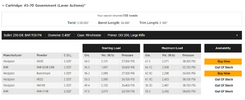Let's put aside Scott's way he is making his videos, that should be another topic, but here is the test he had done using grossly overloaded round 45-70 in Henry lever action rifle. He stated that pressure is "upwards of 200 000 psi". That is about twice of proof load pressure in modern large caliber magnum rifle rounds.
Here is the video, just start it https://www.youtube.com/watch?v=cqNMolE7aZI&t=264s .
As you could see, bolt in receiver didn't move, but barrel gave up. Quite testimony to knowledge and skills of engineers who created this rifle!
I was always curious how strong modern lever action rifles are. Now, I do not have any doubt that they are more than strong enough for any sane load, in any caliber for lever action.
BTW, I found somewhere statement that when Mauser M98 was designed, the goal was to make receiver and bolt so strong that in case of overload, barrel thread will be stripped and barrel should fly forward, but receiver and bolt should stay intact, protecting shooter.
CORRECTION: Steve51, silicosys4 and 3Crows pointed that I was wrong regarding rifles shown in this video. Looking better from beginning, the first rifle shown is late Henry 45-70, with side loading gate. At the first moment I thought that Scott was wrong, because that rifle has very similar design of receiver and bolt as on Marlin rifles. In addition, I omitted front loading feature on end of tube. Also, rifle actually tested was another Henry model, without side loading gate.
This is a great forum, with great and very knowledgeable folks, always ready to help! Thanks to all of you for correcting me!
Here is the video, just start it https://www.youtube.com/watch?v=cqNMolE7aZI&t=264s .
As you could see, bolt in receiver didn't move, but barrel gave up. Quite testimony to knowledge and skills of engineers who created this rifle!
I was always curious how strong modern lever action rifles are. Now, I do not have any doubt that they are more than strong enough for any sane load, in any caliber for lever action.
BTW, I found somewhere statement that when Mauser M98 was designed, the goal was to make receiver and bolt so strong that in case of overload, barrel thread will be stripped and barrel should fly forward, but receiver and bolt should stay intact, protecting shooter.
CORRECTION: Steve51, silicosys4 and 3Crows pointed that I was wrong regarding rifles shown in this video. Looking better from beginning, the first rifle shown is late Henry 45-70, with side loading gate. At the first moment I thought that Scott was wrong, because that rifle has very similar design of receiver and bolt as on Marlin rifles. In addition, I omitted front loading feature on end of tube. Also, rifle actually tested was another Henry model, without side loading gate.
This is a great forum, with great and very knowledgeable folks, always ready to help! Thanks to all of you for correcting me!
Last edited:




